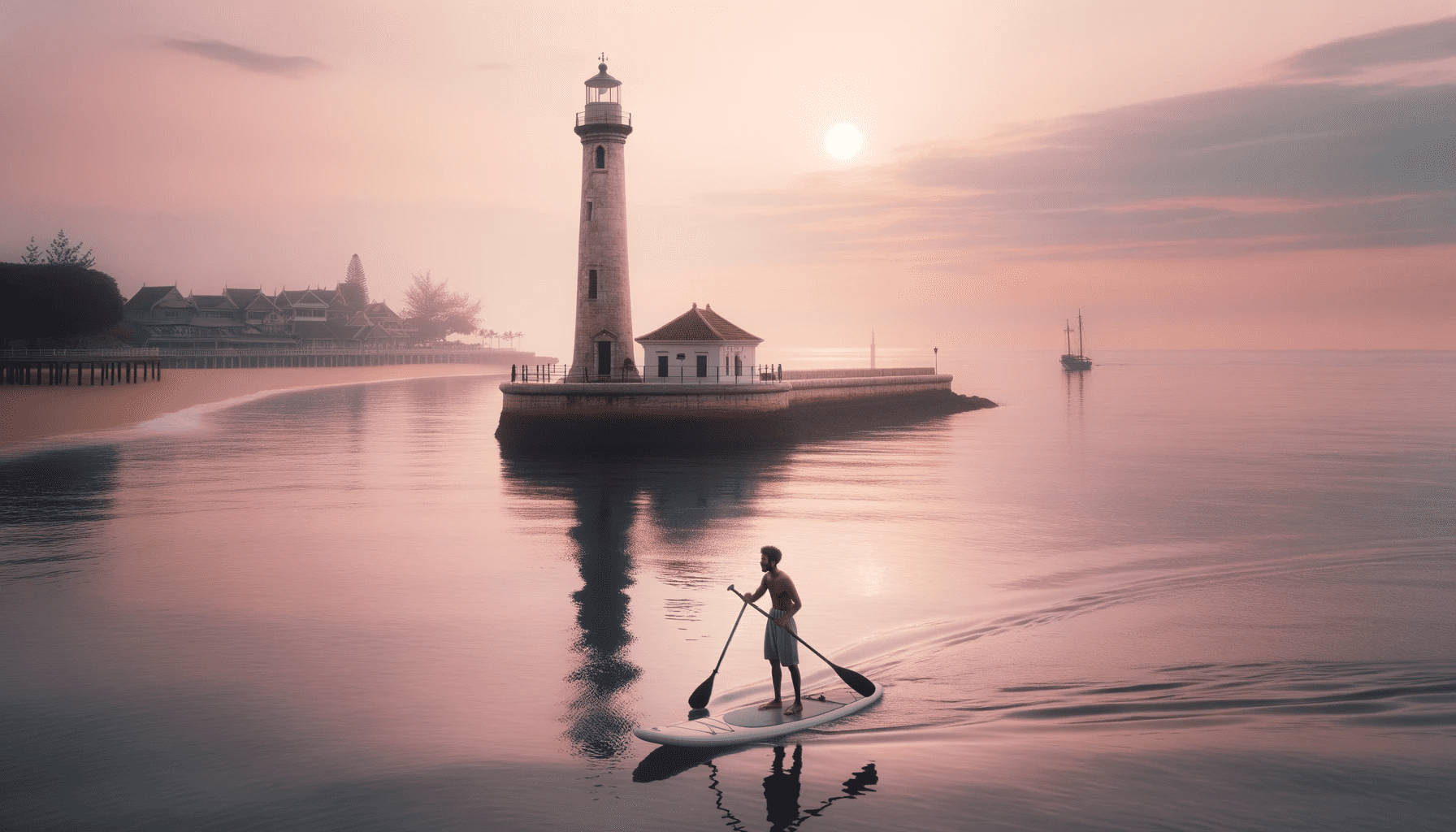Looking to enjoy the freedom and tranquility of paddleboarding on calm lakes? Discover the best beginner-friendly techniques that will have you gliding across the water with ease.
From choosing the right paddleboard to mastering basic strokes, this article will provide you with all the necessary tips and tricks to get started.
So grab your board, embrace the serenity of the lake, and embark on a thrilling adventure that promises both relaxation and excitement.
Key Takeaways
- Choose a wider and longer paddleboard for better stability and balance
- Familiarize yourself with and practice basic paddle strokes such as the forward stroke, sweep stroke, draw stroke, and reverse stroke
- Focus on maintaining proper balance and posture on the paddleboard by selecting the correct paddle length and developing core strength
- Master turns and maneuvers by using your core for balance, positioning the paddle correctly in the water, and practicing different techniques for finesse and control
Choosing the Right Paddleboard
Beginners should consider the dimensions and stability of the paddleboard when choosing the right one for calm lake paddleboarding. The dimensions of the paddleboard play a crucial role in determining its stability and maneuverability on the water. For beginners, it’s advisable to opt for a wider and longer board as it provides better stability and balance. This will help them feel more confident and comfortable while paddleboarding on calm lakes.
When it comes to paddleboarding gear, beginners should look for equipment specifically designed for their skill level. There are many beginner-friendly paddleboards available in the market that offer extra stability and ease of use. These paddleboards often feature wider and more buoyant designs, making them perfect for beginners to practice their skills on calm lake waters.
Additionally, beginners should also consider the type of water they’ll be paddleboarding on. If they plan to paddleboard on rivers, they need to choose a paddleboard that’s more versatile and can handle the currents and obstacles that rivers present. It’s important to choose a paddleboard that’s suitable for the specific conditions they’ll encounter.
With the right paddleboard and gear, beginners can start their journey into the world of paddleboarding on calm lakes. Once they’ve chosen the perfect paddleboard, they can move on to mastering basic paddle strokes to enhance their skills and fully enjoy the freedom and tranquility of paddleboarding on calm lake waters.
Mastering Basic Paddle Strokes
To master basic paddle strokes on calm lakes, beginners can start by familiarizing themselves with the proper use of the paddle through practice and instruction. The paddle is the primary tool for propelling and steering the paddleboard. There are several essential paddle strokes that beginners should learn to navigate effectively on calm lakes.
One of the most fundamental paddle strokes is the forward stroke. To perform this stroke, the paddler should reach forward with the paddle, submerge it in the water, and pull it back towards the tail of the board in a smooth and controlled motion. This stroke helps to propel the paddleboard forward.
Another important paddle stroke is the sweep stroke. It’s used to turn the paddleboard by sweeping the paddle in a wide arc away from the board’s side. By applying pressure on one side of the board, the paddleboard will turn in that direction.
Additionally, beginners should practice the draw stroke, which involves pulling the paddle towards the board to move sideways, and the reverse stroke, which is used to go backward.
Once beginners have mastered these basic paddle strokes on calm lakes, they can progress to learning more advanced paddleboarding techniques for ocean waves or whitewater rivers. These advanced techniques require a higher level of skill and experience.
Transition: Now that beginners have learned the basic paddle strokes, it’s crucial to focus on finding the proper balance and posture on the paddleboard.
Finding the Proper Balance and Posture
Continuing the discussion on mastering basic paddle strokes, beginners can enhance their paddleboarding skills on calm lakes by focusing on finding the proper balance and posture. Achieving the right balance and posture is crucial for maintaining stability and control on the paddleboard.
One of the first steps in finding the proper balance is selecting the correct paddle length. A paddle that’s too long or too short can throw off your balance and make it difficult to maintain control. To determine the proper paddle length, stand upright with your arm raised above your head. The paddle should reach your wrist when the blade is fully submerged in the water.
In addition to paddle length, developing core strength is essential for maintaining balance on the paddleboard. A strong core helps you engage your abdominal and back muscles to stabilize your body and maintain an upright posture. Incorporating exercises like planks, Russian twists, and side planks into your fitness routine can help improve your core strength.
Navigating Turns and Maneuvers
How can paddleboarders effectively navigate turns and maneuvers on calm lakes? When it comes to smoothly transitioning and executing advanced paddle techniques, there are a few key points to keep in mind.
First, maintaining a strong and stable core is essential. This will provide the necessary balance and control needed to execute turns with ease. By engaging the core muscles and using them to initiate the movement, paddleboarders can smoothly shift their weight and change direction without losing stability.
Second, proper paddle placement is crucial. To navigate turns effectively, it’s important to position the paddle in the water at the appropriate angle. This will allow for maximum propulsion and control. By using the paddle as a rudder, paddleboarders can guide themselves through the turn smoothly and effortlessly.
Lastly, practice makes perfect. Navigating turns and executing advanced paddle techniques requires skill and finesse, and the only way to improve is through practice. By dedicating time to honing these skills, paddleboarders can become more confident and proficient in navigating turns and maneuvers on calm lakes.
Safety Tips for Paddleboarding on Calm Lakes
Paddleboarders on calm lakes can ensure their safety by following a few important tips.
First and foremost, it’s essential to have the right equipment. Before heading out onto the water, paddleboarders should check that they’ve a life jacket, a leash to attach themselves to the paddleboard, and a whistle or other signaling device in case of an emergency. It’s also important to choose the right paddleboard for calm lake conditions, ensuring that it’s stable and easy to maneuver.
Another crucial aspect of safety is being aware of the weather conditions. Paddleboarders should always check the weather forecast before heading out and be mindful of any changes in the weather while on the lake. Wind and storms can quickly make calm waters rough and dangerous. It’s recommended to avoid paddleboarding during thunderstorms or strong winds.
In addition, paddleboarders should always inform someone of their plans, including their intended route and estimated time of return. This way, if an emergency arises, help can be alerted promptly.
Frequently Asked Questions
How Do I Choose the Right Clothing and Gear for Paddleboarding on Calm Lakes?
When paddleboarding on calm lakes, it’s important to choose the right clothing and gear. Consider factors like water temperature and weather conditions. Essential items include a wetsuit or board shorts, a life jacket, and a paddle. Stay safe and comfortable by following these clothing and gear tips.
What Are Some Common Mistakes Beginners Make When Attempting Basic Paddle Strokes?
Many beginners make common mistakes when attempting basic paddle strokes. They often struggle with proper technique, leading to instability and lack of control. Learning the correct form and practicing regularly will help avoid these errors.
Is It Necessary to Use a Leash While Paddleboarding on Calm Lakes?
Using a leash while paddleboarding on calm lakes has pros and cons. It provides safety and prevents the board from drifting away, but it can also limit freedom of movement. To improve balance and stability, beginners can practice proper body alignment and engage their core muscles.
Are There Any Specific Techniques for Getting Back on the Paddleboard After Falling Off?
What’s the best way to get back on a paddleboard after taking a plunge? Discover beginner-friendly paddleboarding techniques that will help you regain your balance and confidence on calm lakes.
How Do I Properly Care for and Maintain My Paddleboard to Ensure Its Longevity?
Paddleboard care is essential for its longevity. Proper maintenance tips include regular cleaning, storage options, and timely repairs. To ensure its durability, one should clean it after each use and store it in a dry place.

